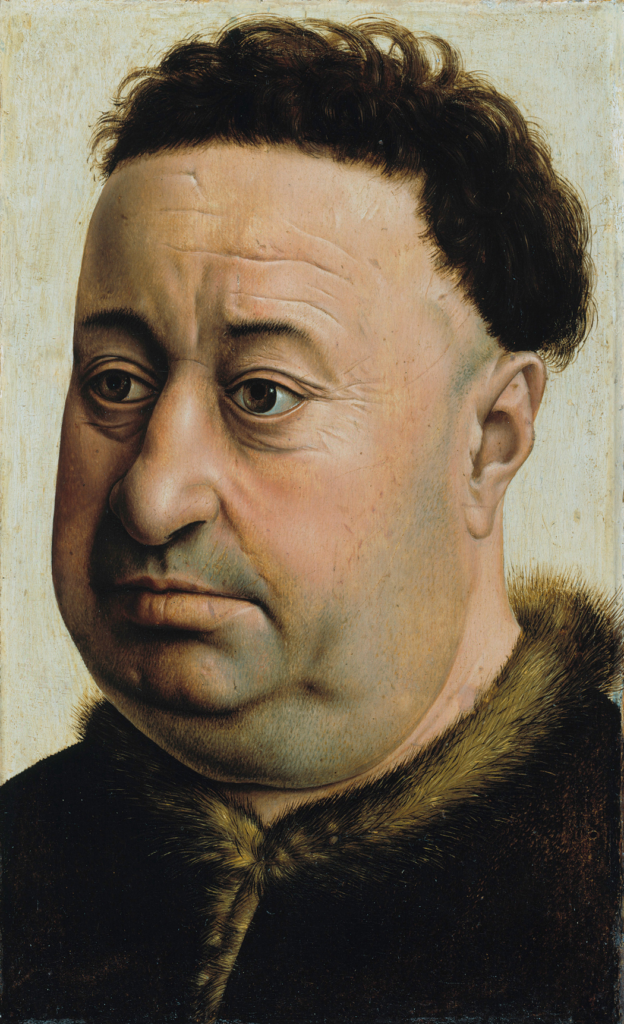The Pinnacle of Portraiture: Rogier van der Weyden
- Rogier van der Weyden (1399-1464), whose full name is Rogier Van der Weyden, was a student of Robert Campin and a painter from the Low Countries, slightly later than Jan van Eyck. Van Weyden, together with his mentor Campin and Jan van Eyck, is considered one of the “Three Masters of the Northern Renaissance.” Van der Weyden holds an extremely important position in the Northern Renaissance due to his groundbreaking achievements in portraiture, elevating it to unprecedented heights, and establishing himself as an artist who did not follow trends but instead carved out a unique style.
- Van der Weyden’s mastery in portraiture reached its peak. The figures in his works are always full of life, even the young subjects, which other artists often find difficult to portray effectively. Most artists shy away from painting young people because their smooth skin and beautiful faces leave little room for expression. In contrast, older individuals or those with distinctive physical traits offer more opportunities for expression. However, Van der Weyden succeeded in bringing vitality and expressiveness to all types of figures, regardless of age or appearance.
- The success of Van der Weyden’s portraits can be attributed, in part, to his treatment of the background. He often used a simple, dark background to emphasize the figure. One of his famous portraits of a young woman, for example, has an impact that rivals that of the Mona Lisa. By using a black background, Van der Weyden made the woman’s image stand out even more. The strong contrast shifts the viewer’s attention directly to the portrait, allowing even previously overlooked details to be more vividly realized.
- Van der Weyden’s portrayal of figures is remarkably rich and three-dimensional, mainly due to his practice of “dressing up” his subjects, which created more room for expression. He added accessories like headgear and makeup, often applying more vivid makeup than what would have been realistic, such as noticeable lipstick and blush. The use of shadows further enhanced the sense of three-dimensionality.
- Another major achievement in Van der Weyden’s portraiture was his meticulous depiction of facial expressions. Before him, figures in portraits were often expressionless, staring stiffly at the viewer. Van der Weyden, however, paid close attention to the changes in his subjects’ eyes and facial expressions. In his famous portrait of a young woman, for instance, the woman looks down to the right, a completely new way of expressing emotion at the time. In another of his masterpieces, “The Descent from the Cross”, Van der Weyden used a medieval-style golden background, yet the figures’ actions and expressions were incredibly dynamic. While many of his contemporaries were still painting characters who might simply furrow their brows, Van der Weyden captured intense sorrow and emotion, infusing the painting with profound grief.
- Van der Weyden achieved unparalleled success in portraiture, but many of his methods were contrary to the trends of his time. For instance, during the Renaissance, most paintings featured landscapes or urban scenes as backgrounds, rather than black or gold. In terms of composition, many artists of the time, especially those in Florence, focused on depth of field, whereas Van der Weyden emphasized the expressions and movements of the figures. Despite having studied in Florence and being mentored by Robert Campin, a leading artist of the time, Van der Weyden was not swayed by the prevailing trends. He broke away from his teacher’s influence, creating his own style and transcending the era’s conventions, ultimately achieving the pinnacle of portraiture.

Van der Weyden’s Portraits – Portrait of a Young Woman

Van der Weyden’s Portraits

Top Left: Leonardo da Vinci’s portrait of a woman
Top Right: Leonardo da Vinci – Mona Lisa

Top Left, Right: Memling’s portrait works

Top Left: Jan van Eyck’s portrait works
Top Right: Raphael’s portrait works

Van der Weyden – The Descent from the Cross

Campin – Altarpiece
Tip
Why do ID photos often look unflattering?
Portraits are usually slightly turned to the side, which makes the subject appear more attractive. On the other hand, ID photos are taken straight on, which tends to make the face appear enlarged and less flattering. This is because there is a certain distance between a person’s eyes, and when we look at someone, we experience parallax, which gives us a sense of depth. However, an ID photo flattens the face onto a two-dimensional plane, removing the parallax and depth, making the face appear larger and less attractive.


